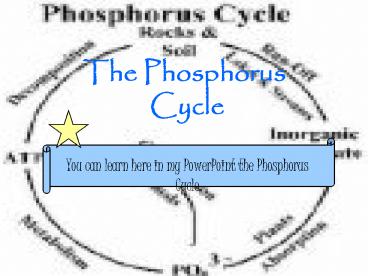The Phosphorus Cycle PowerPoint PPT Presentation
1 / 8
Title: The Phosphorus Cycle
1
The Phosphorus Cycle
- You can learn here in my PowerPoint the
Phosphorus Cycle
2
Phosphorus Cycle
- is the biogeochemical cycle that describes the
movement of phosphorus through the lithosphere,
hydrosphere, and biosphere. Unlike many other
biogeochemical cycles, the atmosphere does not
play a significant role in the movements of
phosphorus, because phosphorus and
phosphorus-based compounds are usually solids at
the typical ranges of temperature and pressure
found on Earth. - enters the environment from rocks or deposits
laid down on the earth many years ago. The
phosphate rock is commercially available form is
called apatite. Other deposits may be from
fossilized bone or bird droppings called guano.
Weathering and erosion of rocks gradually
releases phosphorus as phosphate ions which are
soluble in water. Land plants need phosphate as a
fertilizer or nutrient.
3
The aquatic phosphorus cyclePhosphorus is an
essential nutrient for plants and animals in the
form of ions PO43- and HPO42-. It is a part of
DNA-molecules, of molecules that store energy
(ATP and ADP) and of fats of cell membranes.
Phosphorus is also a building block of certain
parts of the human and animal body, such as the
bones and teeth.
4
Phosphorus normally occurs in nature as part of a
phosphate ion, consisting of a phosphorus atom
and some number of oxygen atoms, the most
abundant form (called orthophosphate) having four
oxygens PO4-. Most phosphates are found as salts
in ocean sediments or in rocks. Over time,
geologic processes can bring ocean sediments to
land, and weathering will carry terrestrial .
Plants absorb phosphates from the soil. The
plants may then be consumed by herbivores who in
turn may be consumed by carnivores. After death,
the animal or plant decays, and the phosphates
are returned to the soil. Runoff may carry them
back to the ocean or they may be reincorporated
into rock.
5
- The primary biological importance of phosphates
is as a component of nucleotides, which serve as
energy storage within cells (ATP) or when linked
together, form the nucleic acids DNA and RNA.
Phosphorus is also found in bones, whose strength
is derived from calcium phosphate, and in
phospholipids (found in all biological
membranes). - Phosphates move quickly through plants and
animals however, the processes that move them
through the soil or ocean are very slow, making
the phosphorus cycle overall one of the slowest
biogeochemical cycles.
6
- Unlike other cycles of matter compounds,
phosphorus cannot be found in air in the as a
gas. This is because at normal temperature and
circumstances, it is a liquid. It usually cycles
through water, soil and sediments. In the
atmosphere phosphorus is mainly small dust
particles. - Phosphorous is one of the longest cycles, and
takes a long time to move from sediments to
living organisms and back to sediments.
7
Pictures of Phosphorus Cycle
8
Prepared byJUNAL MAY E. TUOZO
- Is it nice?
- Did you understand my presentation?

